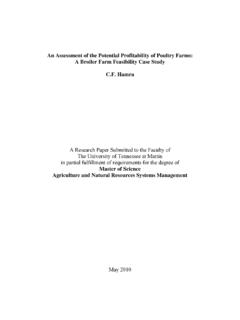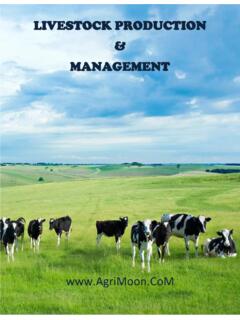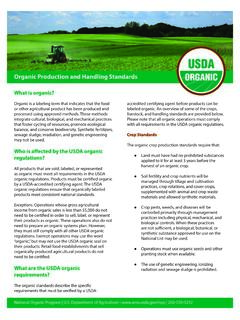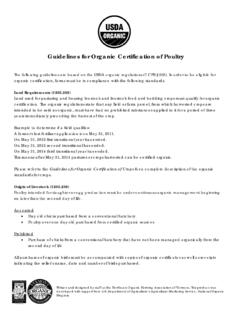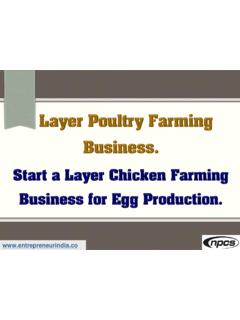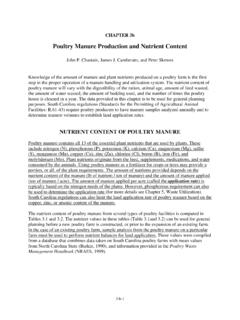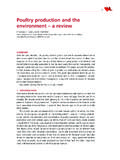Transcription of BIOSECURITY PROCEDURES IN POULTRY PRODUCTION
1 2021 OIE - Terrestrial Animal Health Code - 19/07/20211C H A P T E R 6 . 5 .B I O S E C U R I T Y P R O C E D U R E SI N P O U L T R Y P R O D U C T I O NArticle agents of POULTRY are a threat to POULTRY health and, at times, human health and have significant social andeconomic implications. In POULTRY PRODUCTION , especially under intensive conditions, prevention is the most viable andeconomically feasible approach to the control of infectious PROCEDURES should be implemented with the objective of preventing the introduction and dissemination ofinfectious agents in the POULTRY PRODUCTION chain.
2 BIOSECURITY will be enhanced with the adoption and implementation ofthe principles of Good Agricultural Practices and the Hazard Analysis Critical Control Point (HACCP) and scopeThis chapter deals with BIOSECURITY PROCEDURES in intensive POULTRY PRODUCTION . It should be read in conjunction with theCodex Alimentarius Code of Hygienic Practice for Meat (CAC/RCP 58-2005), Code of Hygienic Practice for Eggs andEgg Products (CAC/RCP 15-1976) and Guidelines for the control of Campylobacter and Salmonella in chicken meat(CAC/GL 78-2011).This chapter identifies several BIOSECURITY measures.
3 The choice of measures to be implemented will vary inaccordance with national conditions, including POULTRY infection status, the risk of introduction and dissemination ofinfectious agents and the cost effectiveness of control on specific infectious agents may be found in relevant disease chapters in the Terrestrial the purposes of this chapter the following definitions apply:Breedersmeans POULTRY destined for the PRODUCTION of fertile eggs for incubation for the purpose of producing bird marketsmeans markets where live birds from various sources and species are sold for slaughter, furtherrearing or OIE - Terrestrial Animal Health Code - 19/07/2021 Chapter BIOSECURITY PROCEDURES in POULTRY productionArticle on the location and construction of POULTRY establishments ( POULTRY farms and hatcheries)a) A suitably isolated geographical location is recommended.
4 Factors to consider include the location of otherpoultry and livestock establishments, wild bird concentrations and the distance from roads used to ) POULTRY establishments should be located and constructed to provide adequate drainage for the site. Run-offor untreated site waste water should not discharge into waterfowl ) POULTRY houses and hatcheries should be designed and constructed (preferably of smooth imperviousmaterials) so that cleaning and disinfection can be carried out effectively. Ideally, the area immediatelysurrounding the POULTRY houses and hatcheries should be paved with concrete or other impervious material tofacilitate cleaning and ) The establishment should be surrounded by a security fence to prevent the entry of unwanted animals ) A sign indicating restricted entry should be posted at the entrance to the measures for POULTRY farmsa)Establishments should be designed to house a single species and a single PRODUCTION type.
5 The designshould also consider the all-in all-out single age group principle. If this is not feasible, the establishmentshould be designed so that each flock can be managed as a separate epidemiological ) POULTRY houses, and buildings used to store feed, eggs or other material, should be constructed andmaintained to prevent the entry of wild birds, rodents and ) Where feasible, the floors of POULTRY houses should be constructed using concrete or other imperviousmaterials and designed so that cleaning and disinfection can be carried out ) Where feasible, feed should be delivered into the farm from outside the security measures for hatcheriesa) The design of the hatchery should take account of work flow and air circulation needs, with one way flow movement of eggs and day-old birds and one way air flow in the same ) The hatchery buildings should include physical separation of areas used for the following:i) personnel changing, showering and sanitary facilities;ii) receipt, storage and transfer of eggs;iii) incubation;iv) hatching.
6 V) sorting, sexing and other handling of day-old birds;vi) storage of egg boxes and boxes for day-old birds, egg flats, chick box liners, chemicals and other items;vii) equipment washing;viii) waste disposal;ix) dining facilities for personnel;x) office BIOSECURITY PROCEDURES in POULTRY production2021 OIE - Terrestrial Animal Health Code - 19/07/20213 Article applicable to the operation of POULTRY establishments ( POULTRY farms and hatcheries)a) All establishments should have a written BIOSECURITY plan. Personnel in the establishments should haveaccess to basic training in BIOSECURITY relevant to POULTRY PRODUCTION and understand the implications to animalhealth, human health and food ) There should be good communication between personnel involved in the POULTRY PRODUCTION chain to ensurethat steps are taken to minimise the introduction and dissemination of infectious ) Traceability at all levels of the POULTRY PRODUCTION chain should be )
7 Records should be maintained on an individual flock basis and include data on bird health, PRODUCTION ,medications, vaccination, mortality and surveillance. In hatcheries, records should include data on fertility,hatchability, vaccination and treatments. Records should be maintained on cleaning and disinfection of farmand hatchery buildings and equipment. Records should be readily available for inspection on ) Monitoring of POULTRY health on the establishment should be under the supervision of a ) To avoid the development of antimicrobial resistance, antimicrobial agents should be used in accordance withrelevant directions of the Veterinary Services and manufacturer s instructions and in accordance withChapters , , and )Establishments should be free from unwanted vegetation and debris that could attract or harbour )
8 PROCEDURES for the prevention of entry of wild birds into POULTRY houses and buildings, and the control of verminsuch as rodents and arthropods should be ) Access to the establishment should be controlled to ensure only authorised persons and vehicles enter ) All personnel and visitors entering an establishment should follow a BIOSECURITY procedure. The preferredprocedure is for visitors and personnel entering the establishment to shower and change into clean clothesand footwear provided by the establishment. Where this is not practical, clean outer garments (coveralls oroveralls, head covering and footwear) should be provided.
9 Entry of visitors and vehicles should be registeredby the ) Personnel and visitors should not have had recent contact with other POULTRY , POULTRY waste, or poultryprocessing plant(s). This time period should be based on the level of risk of transmission of infectious will depend on the POULTRY PRODUCTION purpose, BIOSECURITY PROCEDURES and infection ) Any vehicle entering an establishment should be cleaned and disinfected in accordance with a biosecurityplan. Delivery vehicles should be cleaned, and disinfected before loading each consignment of eggs measures for all POULTRY farmsa) Whenever possible, the all-in all-out single age group principle should be used.
10 If this is not feasible andseveral flocks are maintained on one establishment, each flock should be managed as a separateepidemiological ) All personnel and visitors entering a POULTRY house should wash their hands with soap and water or sanitizethem using a disinfectant. Personnel and visitors should also change footwear, use a boot spray or use aproperly maintained disinfectant footbath. The disinfectant solution in the footbath should be changed on aregular basis to ensure its efficacy, in accordance with the manufacturer s ) Any equipment should be cleaned and sanitized before being taken into a POULTRY ) Animals, other than POULTRY of the appropriate (resident) species and age, should not be permitted access topoultry houses.











